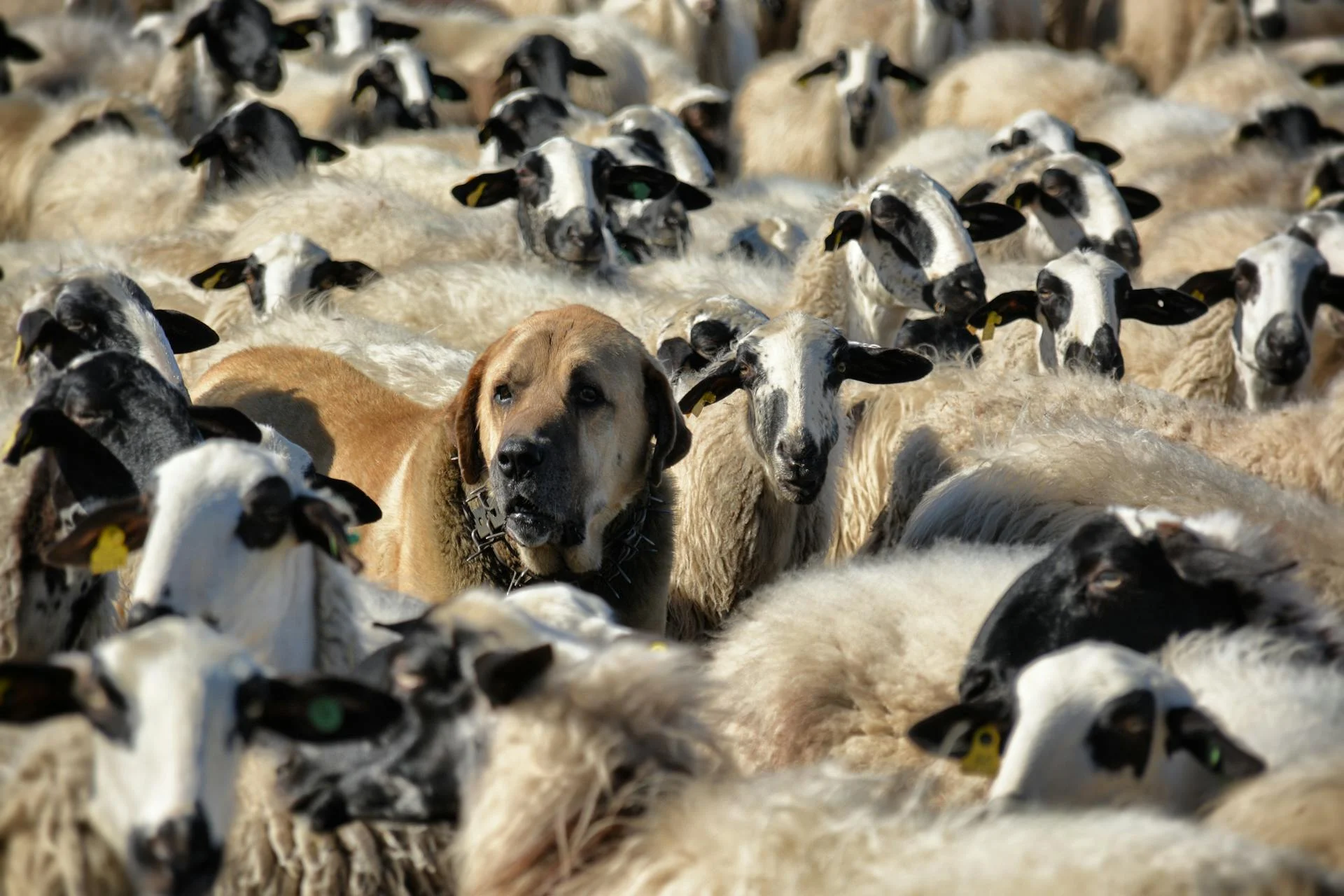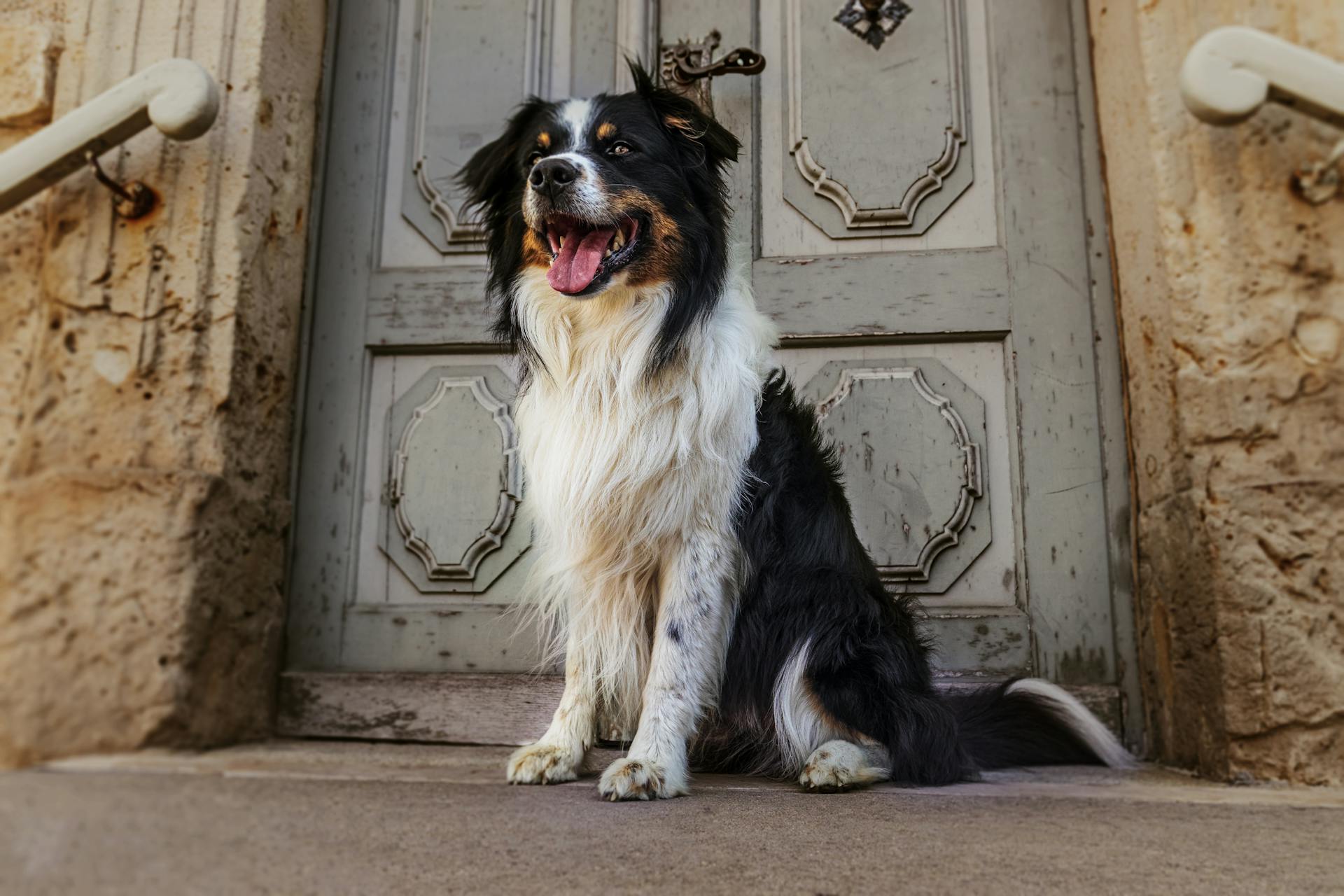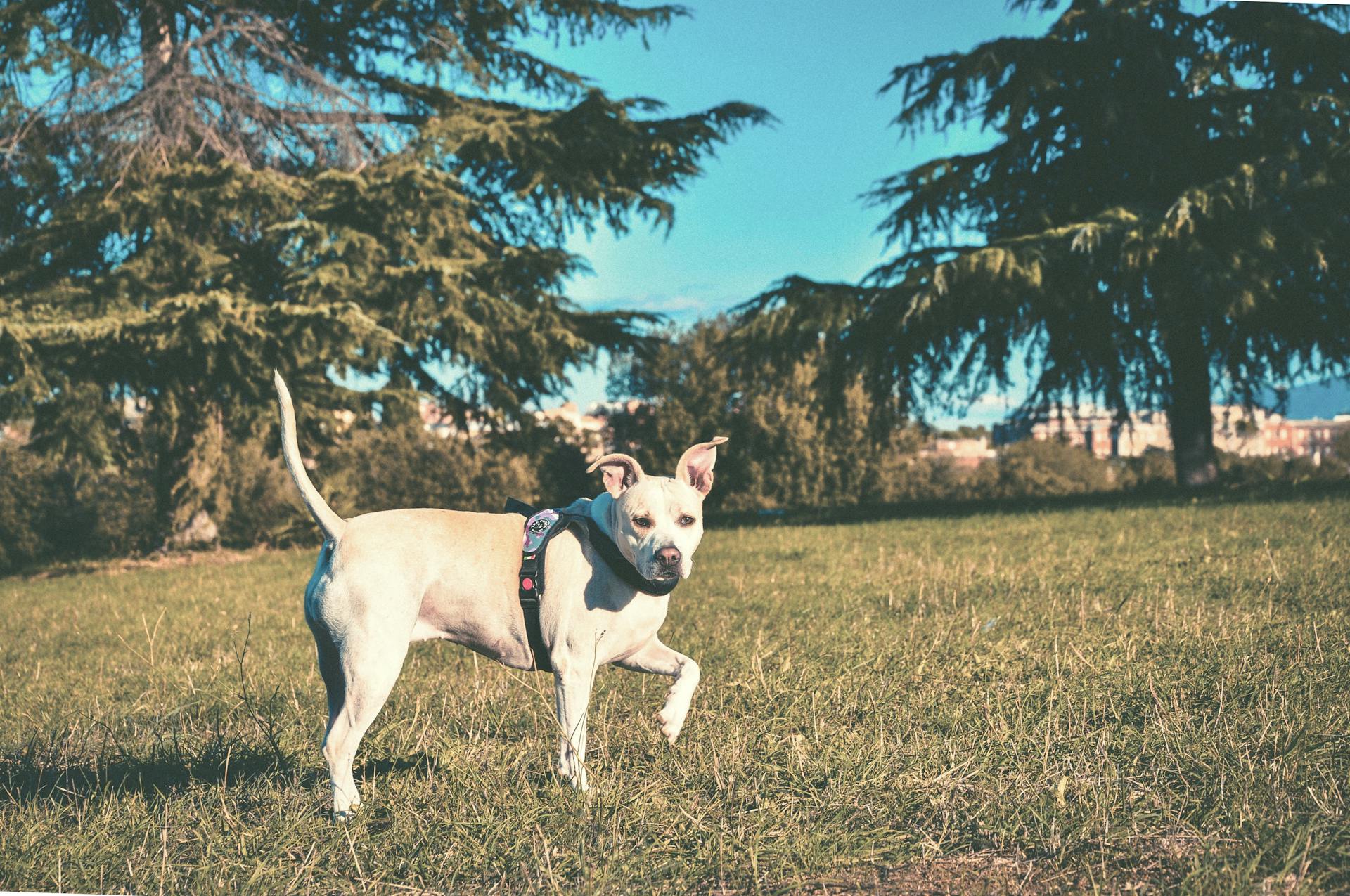
The Akbash Pyrenees is a large and powerful dog breed that originated in Turkey and Spain. They are a cross between an Akbash and a Pyrenees, making them a unique and fascinating breed.
Originally bred to guard livestock, Akbash Pyrenees are naturally protective of their family and territory. They have a strong instinct to defend what's theirs, which can sometimes be misinterpreted as aggression.
These dogs are built for rugged terrain and can thrive in a variety of climates, from hot to cold. They have a thick double coat that sheds heavily, so regular grooming is a must.
Physical Characteristics
The Akbash Pyrenees is a large breed, easily surpassing 100 pounds. They have a thick and fluffy coat that can give them an even larger appearance.
Their size can vary, but they are typically classified as large or giant dogs. In terms of height, males can range from 27-32 inches (69-81 cm), while females are slightly shorter at 25-29 inches (63-74 cm).
Here's a breakdown of their size and weight:
Size and Weight

The Akbash Pyrenees is a large breed, easily surpassing 100 pounds, with a slimmer build than the stocky Great Pyrenees. Their thick and fluffy coat can give them an even larger appearance.
They are typically found in white, with markings such as tan or grey spots. The Akbash Pyrenees can have a range of weights, with males weighing between 90-140 pounds and females weighing between 75-105 pounds.
Here's a breakdown of the average weights for an Akbash Pyrenees:
The height of an Akbash Pyrenees also varies, with males reaching 27-32 inches and females reaching 25-29 inches.
Coat Color & Grooming
The Akbash Pyrenees has a thick double coat that needs regular maintenance to prevent matting and skin issues. Brushing should be done several times a week, and bathing is best done on an as-needed basis, rarely more than once a month.
Their coats are prone to matting, especially in the ears and paws, so it's essential to check these areas regularly. Regular brushing will help prevent matting and keep their coat healthy.
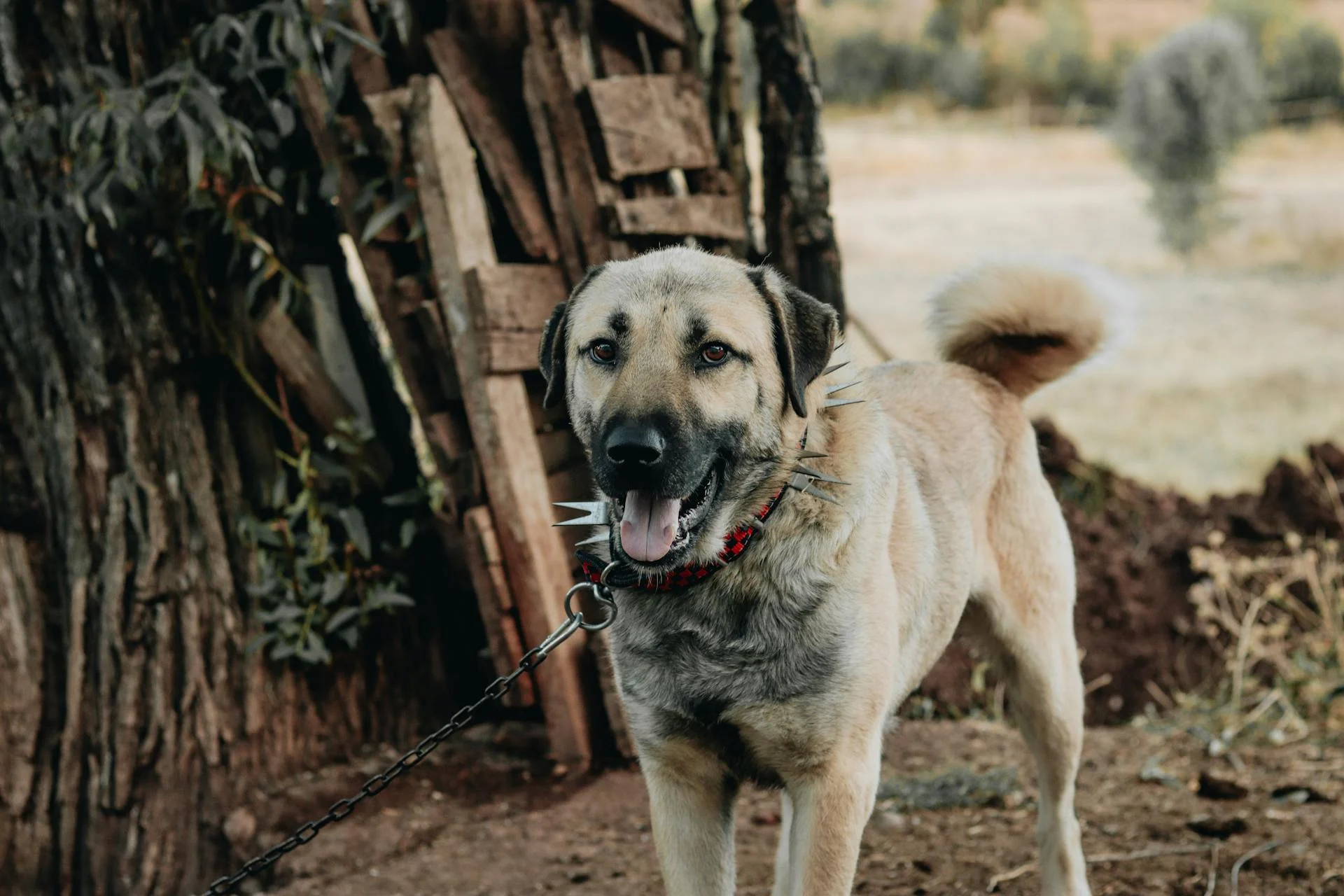
Both the Akbash and Great Pyrenees have a thick double coat, but the Akbash sheds more heavily, especially during the spring and fall. Regular brushing is essential to remove loose hair and prevent matting.
Here's a comparison of the grooming needs of the Akbash and Great Pyrenees:
Both breeds require average grooming effort, but the Akbash may need more frequent bathing due to its tendency to get dirty while patrolling and protecting its territory.
Temperament and Behavior
The Akbash Pyrenees is a loyal and loving breed that thrives on spending time with family. They're also good at occupying themselves, making them a great choice for busy owners who need a low-maintenance companion.
One thing to keep in mind is that Akbash Pyrenees dogs are a bit more sensitive than other breeds, so they don't tolerate harsh punishment or irregular daily routines well. They're also receptive to their owner's emotions, which makes them wonderful family companions.
Akbash Pyrenees dogs have a strong instinct to protect their families, which can sometimes manifest in barking and patrolling their territory. They're wary of strangers and can be reserved, but they're not aggressive unless provoked.
In terms of socialization, it's a good idea to work on socialization from a young age to help your Akbash Pyrenees feel more comfortable around new people and dogs.
Here are some key personality traits of the Akbash Pyrenees breed:
- Independent
- Alert
- Courageous
- Intelligent
- Affectionate
- Loyal
- Gentle
- Strong-willed
- Fearless
Akbash Pyrenees dogs have a high wanderlust potential, which means they have a strong desire to explore the world. This can sometimes lead to them escaping from home, so it's essential to keep them on a leash or provide a secure enclosure.
Overall, the Akbash Pyrenees is a great breed for active families who want a loyal and loving companion. With proper training and socialization, they can thrive in a variety of environments and make wonderful working dogs and loyal companions.
A different take: Most Loyal Dog Breed
Care and Health
The Akbash Pyrenees is a healthy breed, but like all breeds, it's not immune to certain health issues. Hip Dysplasia, Obesity, Hypothyroidism, and Bloat are some genetic predispositions to be aware of.
Regular exercise is essential for the Akbash Pyrenees. They need at least an hour of daily walk or hike, and enjoy indoor or outdoor play like fetch or tug-of-war. This breed likes to roam, so apartment living may not be the best fit.
To keep your Akbash Pyrenees healthy, schedule annual physical check-ups with your veterinarian. If your dog shows any symptoms, don't hesitate to call. Here are some common health issues to watch out for:
The Akbash Pyrenees has an average lifespan of 11 years, which is relatively long compared to other breeds. They can adapt to cold weather conditions, making them a great choice for mountain living.
Care Requirements
The Akbash Pyrenees is a breed that needs regular exercise to stay happy and healthy. They require at least an hour of daily walk or hike, and they also enjoy indoor or outdoor play like fetch or tug-of-war.
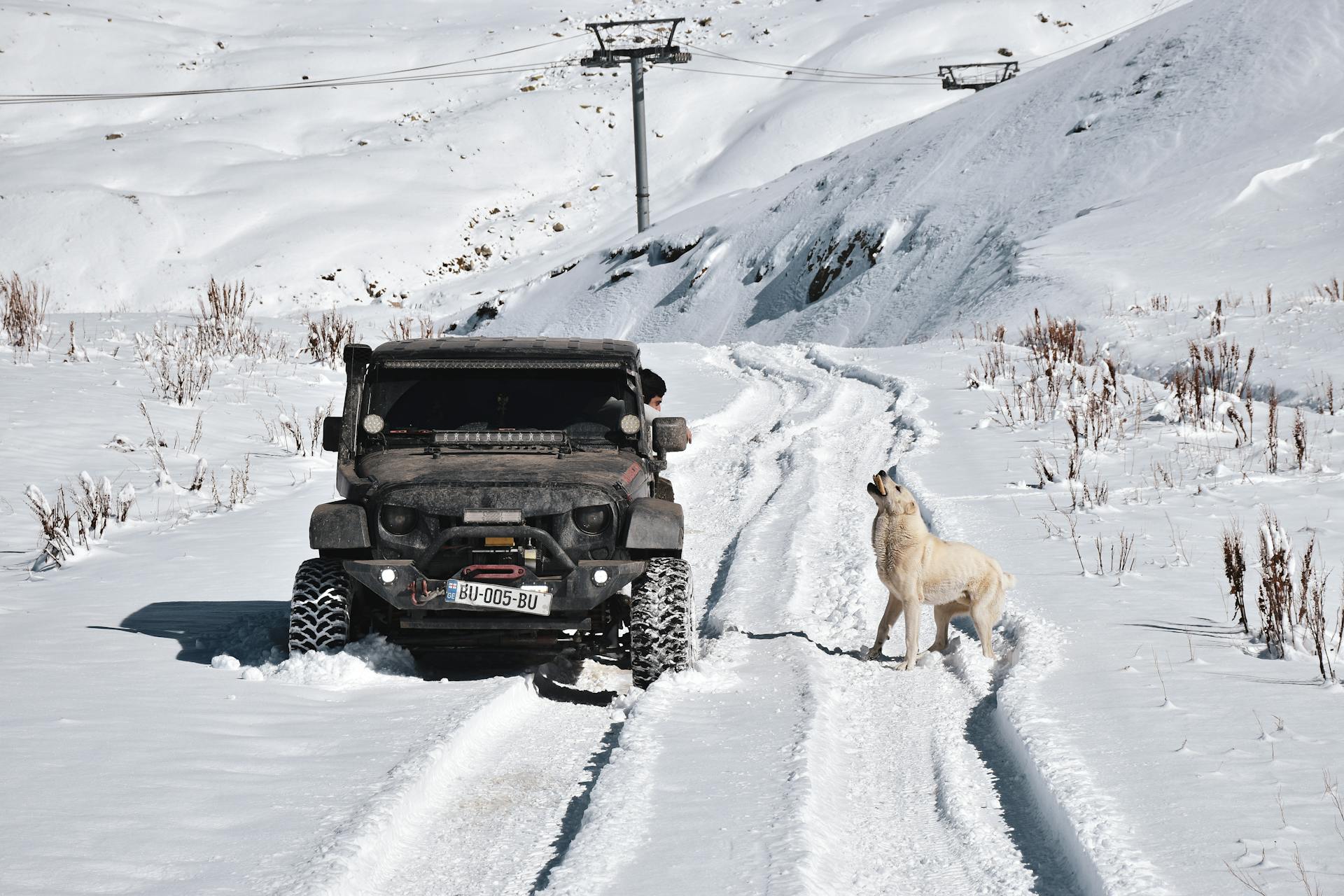
Their high energy levels mean they're not suited for apartment living, as they like to roam and need space to move around. If you're considering bringing an Akbash Pyrenees into your home, make sure you have a spacious yard or access to regular outdoor activities.
To keep your Akbash Pyrenees looking and feeling their best, regular grooming is essential. They require average grooming effort, which means they need regular brushing and occasional bathing.
Here's a rough guide to their grooming needs:
Their thick coat sheds moderately, so be prepared for regular brushing to prevent matting and tangling. And, as with any breed, regular bathing is essential to keep them clean and smelling fresh.
Health and Lifespan
The Akbash Pyrenees is a generally healthy breed, but like all breeds, it's not immune to health issues.
Regular check-ups with your vet are crucial to catch any potential problems early on. The Akbash Pyrenees should have a complete physical check-up at least once per year.
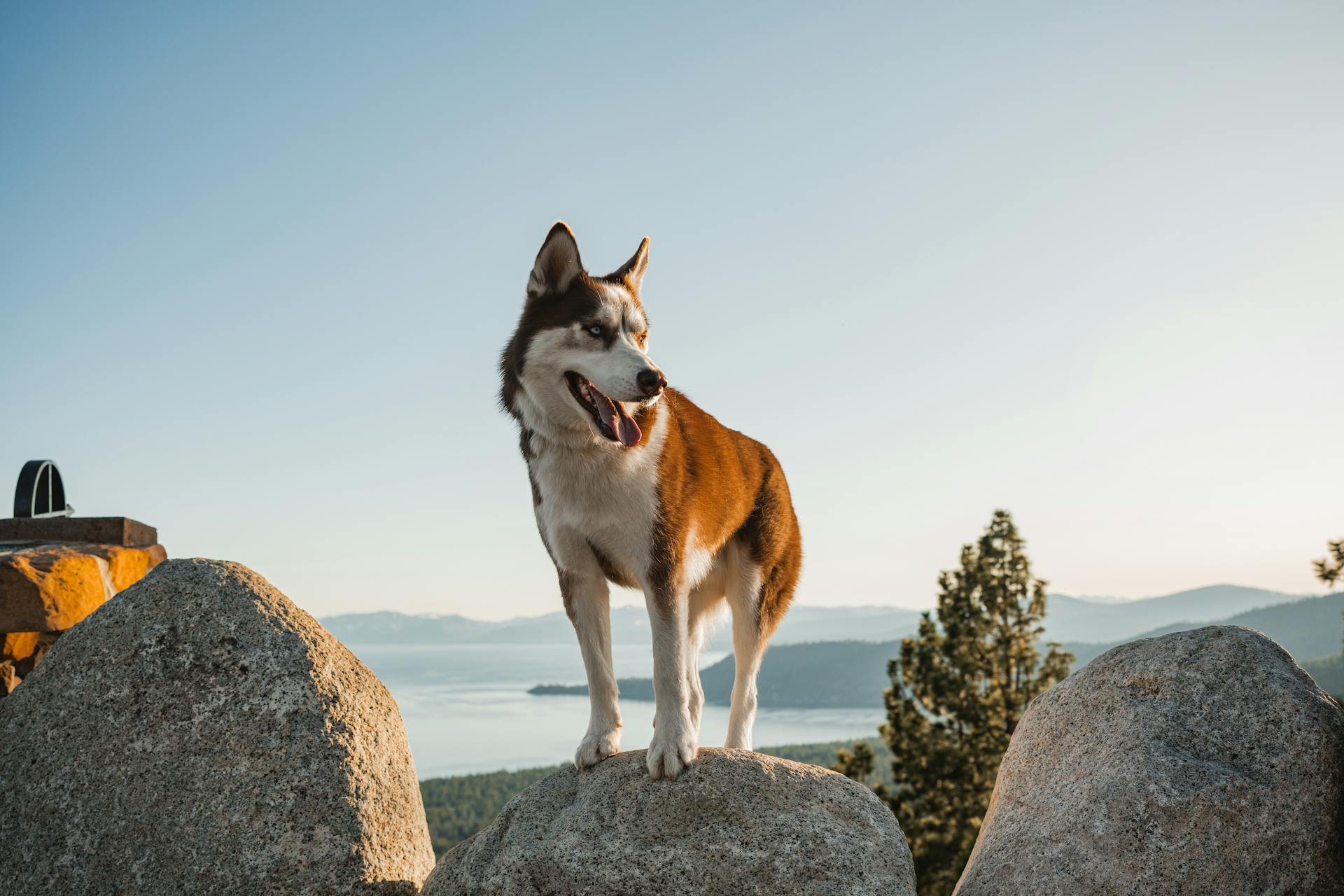
Some common health issues that can affect the Akbash Pyrenees include cataracts, hip dysplasia, luxating patella, hypothyroidism, umbilical hernias, bloat, epilepsy, heart problems, entropion, drug sensitivity, elbow dysplasia, and Addison's disease.
Akbash Pyrenees tend to have more frequent health issues than the Great Pyrenees, who are commonly considered healthy dogs.
The average lifespan of an Akbash Pyrenees is 11 years, with a range of 10-12 years. This is similar to the average lifespan of the Great Pyrenees, which is also 11 years.
Here's a list of some common health issues that can affect both breeds:
- Cataracts
- Hip Dysplasia
- Luxating Patella
- Hypothyroidism
- Umbilical Hernias
- Bloat
- Epilepsy
- Heart Problems
- Entropion
- Drug Sensitivity
- Elbow Dysplasia
- Addison's Disease
The Akbash Pyrenees can adapt well to cold weather conditions, making them a good choice for dog owners who live in areas with cold climates.
How Old is My Pet in Human Years?
Calculating your pet's age in human years can be a fun and interesting way to understand their development and growth. For an Akbash Pyrenees, here's a rough estimate of their age in human years.
Here's an interesting read: Great Pyrenees Age
A 1 year old Akbash Pyrenees is equivalent to a 15 year old human, which is surprisingly close to the average human lifespan.
A 2 year old Akbash Pyrenees is equivalent to a 20 year old human, indicating they're still in their early adulthood.
A 3 year old Akbash Pyrenees is equivalent to a 25 year old human, showing they're reaching their prime.
A 4 year old Akbash Pyrenees is equivalent to a 30 year old human, which is roughly the average age for many adults.
Here's a quick reference guide to help you estimate your Akbash Pyrenees' age in human years:
- 1 year old Akbash Pyrenees ≈ 15 human years
- 2 year old Akbash Pyrenees ≈ 20 human years
- 3 year old Akbash Pyrenees ≈ 25 human years
- 4 year old Akbash Pyrenees ≈ 30 human years
- 5 year old Akbash Pyrenees ≈ 35 human years
- 6 year old Akbash Pyrenees ≈ 40 human years
- 7 year old Akbash Pyrenees ≈ 45 human years
- 8 year old Akbash Pyrenees ≈ 50 human years
- 9 year old Akbash Pyrenees ≈ 55 human years
- 10 year old Akbash Pyrenees ≈ 60 human years
- 11 year old Akbash Pyrenees ≈ 65 human years
- 12 year old Akbash Pyrenees ≈ 70 human years
- 13 year old Akbash Pyrenees ≈ 75 human years
- 14 year old Akbash Pyrenees ≈ 80 human years
- 15 year old Akbash Pyrenees ≈ 85 human years
- 16 year old Akbash Pyrenees ≈ 90 human years
- 17 year old Akbash Pyrenees ≈ 95 human years
- 18 year old Akbash Pyrenees ≈ 100 human years
Reproducibility
The reproducibility of Akbash Pyrenees is an essential aspect of their care and health. They typically take 60-64 days to become pregnant.
The reproductive cycle of a female Akbash Pyrenees involves four stages: Proestrus, Estrus, Diestrus, and Anestrus. Proestrus lasts about 9 days, during which the female starts to attract males, and the vulva becomes swollen with a bloody discharge.
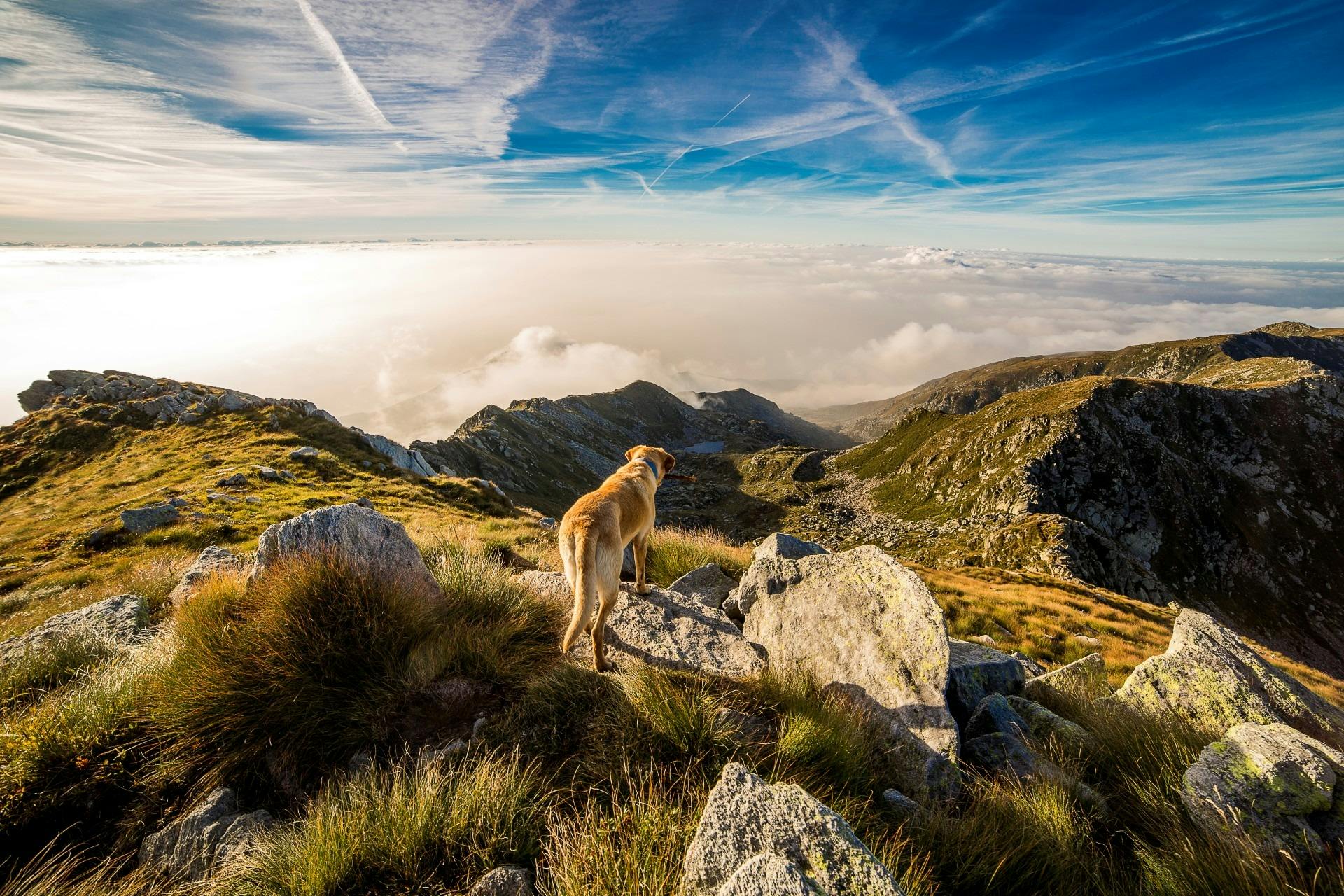
The Estrus stage is when the female is receptive to the male, lasting 3 to 11 days. You can notice this stage by the soft and enlarged vulva, and a decrease in discharge with a lighter color.
The Diestrus stage occurs around day 14, where the female's discharge changes to vivid red and eventually comes to an end. The vulva returns to its average size, and the female will no longer permit mating.
The Anestrus stage is the time frame between heat periods, which usually lasts about six months.
Akbash Pyrenees typically have one litter per year, as more frequent breeding is not healthy for the mother or the puppies.
Here's a summary of the reproductive facts for Akbash Pyrenees:
Training and Behavior
The Akbash Pyrenees is a breed that's known for its intelligence, but also for being a bit stubborn at times. They rank average in the intelligence ranking of dogs, which means they understand and remember new commands after an average of 25-40 repetitions.
Training an Akbash Pyrenees requires patience and consistency. They find out the association between commands and actions quite quickly, but they can be strong-willed and may require a firm and consistent approach.
Positive reinforcement techniques work best with this breed, as they respond well to rewards and praise. It's essential to start training from an early age and establish clear boundaries to prevent any behavioral issues.
One of the best things about the Akbash Pyrenees is their loyalty to their families. They are calm, gentle, and patient, making them excellent choices for families with children. They are also intelligent and independent, which can sometimes make training a bit challenging.
Here's a summary of the Akbash Pyrenees' trainability and behavior:
Overall, the Akbash Pyrenees is a loyal and loving breed that makes a great companion for families and individuals who are willing to put in the time and effort to train them. With patience, consistency, and positive reinforcement, you can develop a strong bond with your Akbash Pyrenees and enjoy the many rewards that come with owning this wonderful breed.
General Information
The Akbash and the Great Pyrenees are both large, white, and fluffy dog breeds that have distinct origins and histories.
The Akbash originated in Turkey and has been used for centuries to protect livestock from predators such as wolves and bears.
Both breeds have a long history of working closely with humans and have proven to be reliable and loyal companions.
Origin and History
The Akbash Pyrenees is a mixed breed that doesn't have its own distinct history, but its parent breeds are well known and loved.
The Akbash originated in Turkey as a livestock guardian approximately 3000 years ago. It was bred to protect livestock from predators like wolves and bears.
The Great Pyrenees, on the other hand, originated in central Asia as a shepherd and protector of livestock. It's also known for its loyalty and independent nature.
Both breeds have a long history of working closely with humans and have proven to be reliable and loyal companions.
Recognition
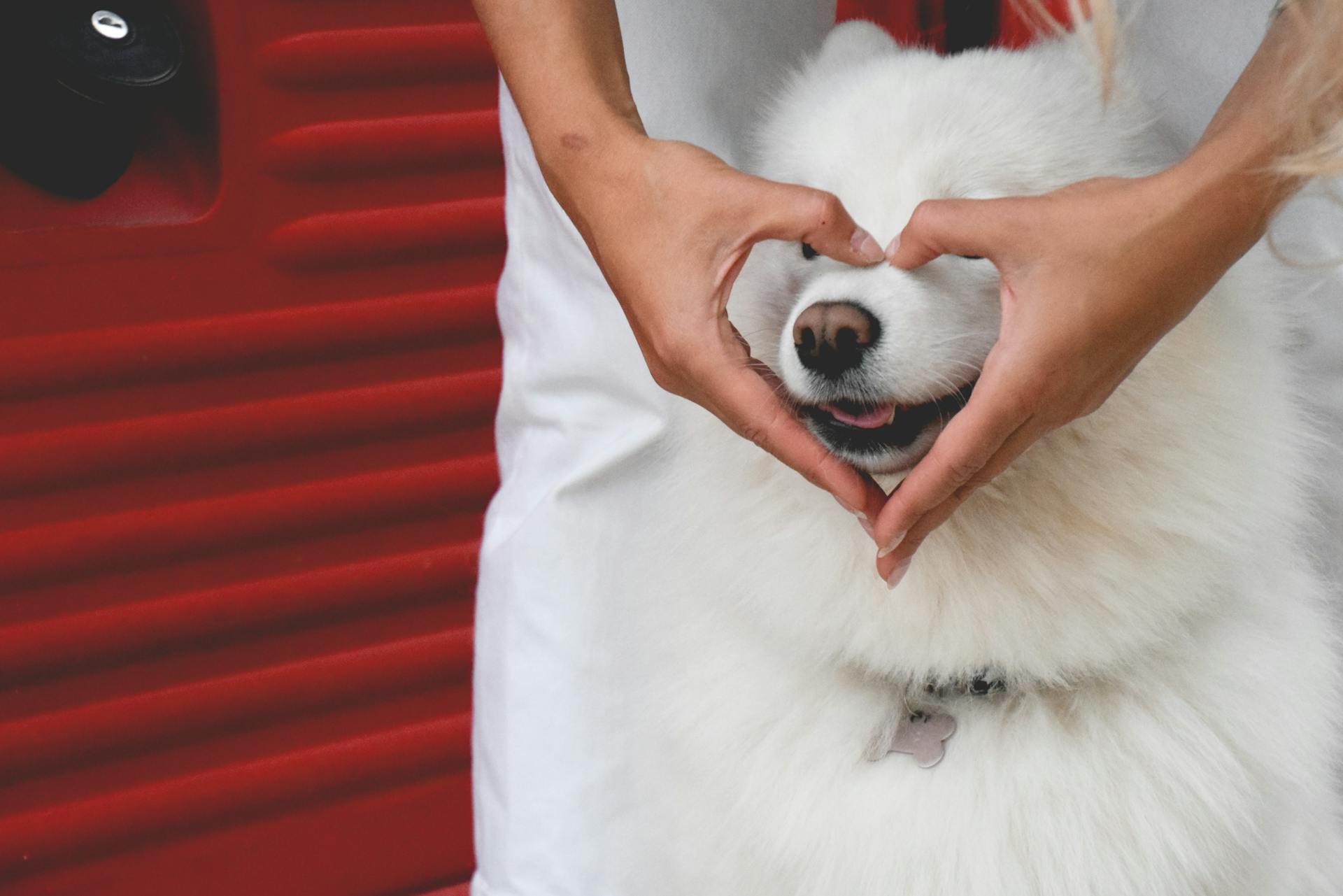
The Akbash Pyrenees is a unique breed with its own set of characteristics. Not recognized by the American Kennel Club, it doesn't meet their breed standards.
The Fédération Cynologique Internationale (FCI) also doesn't recognize the Akbash Pyrenees. This means it doesn't meet their breed requirements either.
Here's a quick rundown of the breed's recognition status:
Pros and Cons
The Akbash Pyrenees is a wonderful breed, and like any dog, it has its pros and cons. One of the biggest advantages is their trainability – they're easy to train, making them a great choice for novice owners.
Their watchdog ability is also top-notch, making them one of the best breeds for security.
Akbash Pyrenees dogs are adaptable and can thrive in different living environments, making them a great choice for families who like to travel or move frequently.
They're also kid-friendly, cat-friendly, and suitable for senior citizens, which is a big plus for many families.
Here's an interesting read: One Eye Shih Tzu
Here are some key pros of the Akbash Pyrenees breed:
- Trainability: Easy to train
- Watchdog Ability: One of the best watchdogs
- Adaptability: Adapts well to lifestyle changes and different living environments
- Child Friendly: Kid-friendly dogs
- Cat Friendly: Cat-friendly dogs
- Senior Citizens Friendly: Suitable for elderly people
- Good For First Time Owners: Good for novice owners
However, there are also some cons to consider. They don't do well with allergy sufferers, and their shedding level is above average, so be prepared for regular grooming.
Reproducing
The Akbash Pyrenees breed has a unique reproductive cycle that's worth understanding if you're considering bringing one home. The female Akbash Pyrenees is pregnant for about 60-64 days.
Breeding frequency is crucial for the health of the mother and puppies. It's recommended to breed the Akbash Pyrenees only once a year, as more frequent breeding can be detrimental to their well-being.
If you're expecting a litter, you can anticipate having 6-9 puppies. This is a relatively standard litter size for the breed.
Here's a quick rundown of the reproductive cycle:
Keep in mind that the Akbash Pyrenees breed is not the only one with a unique reproductive cycle. In fact, the Akbash Dog and Great Pyrenees breeds have similar gestation lengths and litter frequencies.
Pros and Cons
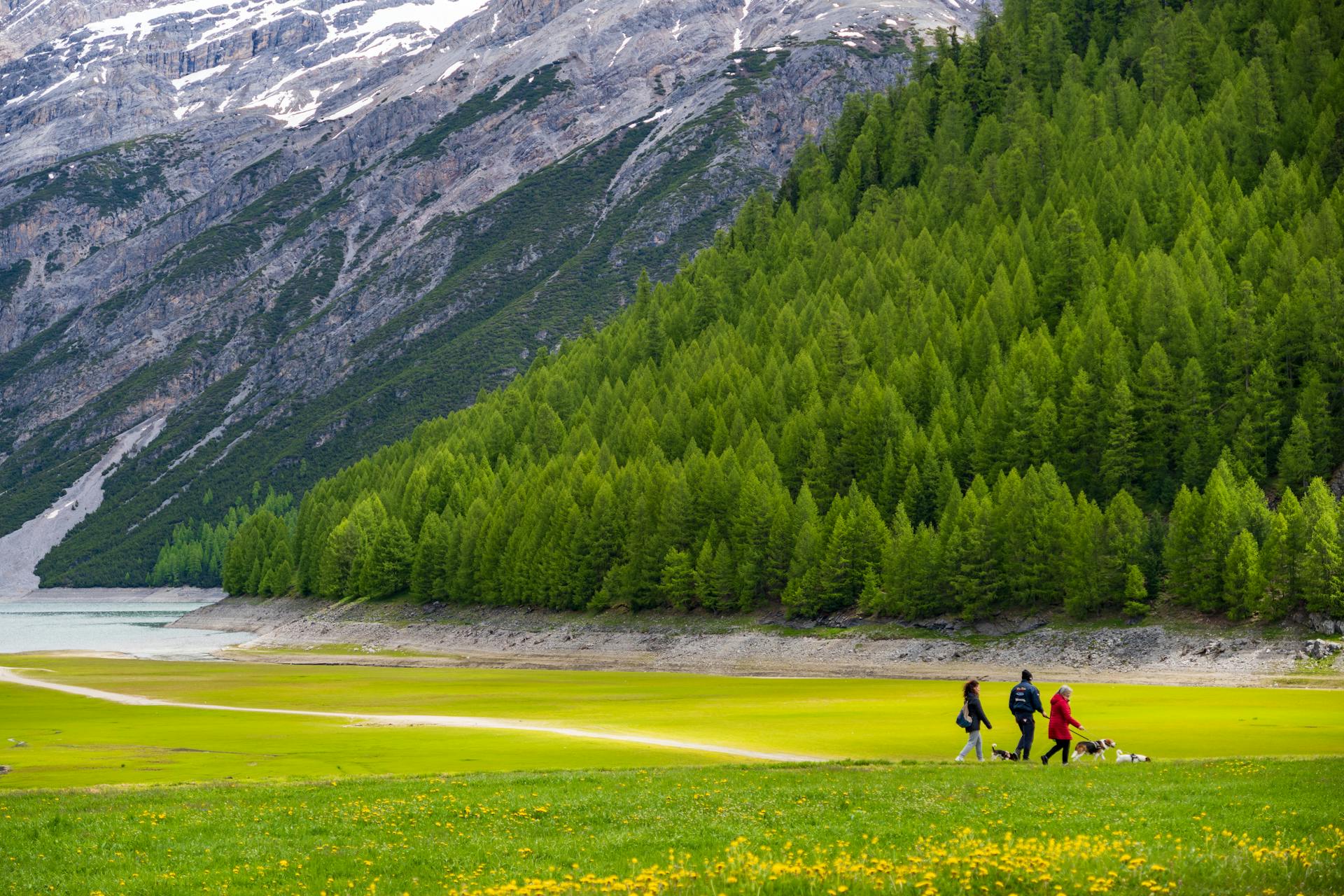
The Akbash Pyrenees breed has its fair share of advantages and disadvantages. Let's dive into the pros and cons.
They're incredibly easy to train, making them a great choice for novice owners. This breed is also one of the best watchdogs, providing excellent security for families.
Akbash Pyrenees dogs adapt well to lifestyle changes and different living environments, making them a great fit for families who like to travel or move frequently.
One of the standout features of this breed is their kid-friendly nature, making them an excellent choice for families with children.
On the other hand, they don't do well with allergy sufferers, causing allergic reactions due to their shedding.
If you're a senior citizen or a first-time owner, the Akbash Pyrenees breed is a great choice due to their easy-going personality.
However, they shed above average, which can be a challenge for some owners.
They have high wanderlust potential, which means they may try to explore the world if they're not properly trained or exercised.

Here are some key pros and cons of the Akbash Pyrenees breed:
- Easy to train
- One of the best watchdogs
- Adaptable to lifestyle changes and living environments
- Kid-friendly
- Cat-friendly
- Recommended for senior citizens and first-time owners
- Good for cart pulling or drafting
- Not hypoallergenic
- Shedding level: above average
- Weight gain potential: average to high
- High wanderlust potential
- Not apartment-friendly
- Not office-friendly
Good
The good news about these two dog breeds! Akbash Dogs and Great Pyrenees are both great companions for families with kids, as they are kid-friendly dogs. They're perfect for households with little ones running around.
Both breeds are also good for novice owners, thanks to their easy-going personalities. They're relatively low-maintenance and easy to care for, making them a great choice for first-time dog owners.
Here are some specific pros to consider:
- Akbash Dogs are good for elderly people, as they are usually recommended for seniors.
- Great Pyrenees dogs are also suitable for elderly people, making them a great option for seniors who want a loyal companion.
- Akbash Dogs are generally friendly towards other pets, including cats and other dogs.
- Both breeds are average friendly towards other dogs, making them a good choice for families with multiple pets.
One thing to keep in mind is that both breeds have their own unique characteristics, and it's essential to research and understand their needs and personalities before bringing one home.
Frequently Asked Questions
How big do Akbash Pyrenees mix get?
Akbash Pyrenees mixes can grow to be quite massive, easily surpassing 100 pounds due to their thick coat and large size. This breed mix is not for the faint of heart, requiring a significant amount of space and care.
Are Akbash good family dogs?
Yes, Akbash dogs make excellent family pets, but they do require early socialization to ensure they get along well with children and other pets.
Featured Images: pexels.com
